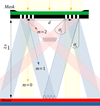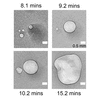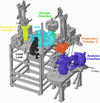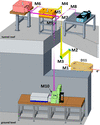issue contents
May 2024 issue

Cover illustration: Synchrotron infrared nanospectroscopy has been proven feasible in fourth-generation storage rings. The minimalistic optical setup of the IMBUIA beamline, installed at the 5-MBA machine Sirius, has successfully managed to collect infrared radiation from the dense magnetic lattice of this accelerator (see Santos, Lordano, Mayer, Volpe, Rodrigues, Meyer, Westfahl Jr and Freitas, pages 547–556). This reported advancement underscores the benefits of the exceptional stability of these machines for operating low-energy end stations.
facility information
scientific commentaries
Open  access
access
 access
accessWith several fourth-generation, or diffraction-limited, storage rings and multiple beamlines in operation, the missing range of the spectrum was infrared…until recently.
PhotonMEADOW2023 workshop
Open  access
access
 access
accessAn iterative method to accurately map wavefront slope measurements from a downstream wavefront random modulator to a curved X-ray mirror surface is presented, addressing a significant challenge in at-wavelength metrology. The results show a substantial improvement over conventional approaches, enhancing the precision of at-wavelength metrology techniques for improved beamline operations.
Open  access
access
 access
accessA quick way of wavefront error analysis of a focusing optics using SHADOW is presented, that is required for fourth-generation light sources. The method is developed to optimize the focal spot and intensity of a non-ideal optics by designing a customized phase corrector.
X-ray spectroscopy for functional materials
Open  access
access
 access
accessMachine-learning methodology improves the sensitivity of XANES spectra to metal–metal bond distances in a bridged configuration.
Open  access
access
 access
accessThis study presents iterative Bragg peak removal with automatic intensity correction (IBR-AIC) for X-ray absorption spectroscopy (XAS), a new method targeting Bragg peak interference in the analysis of crystalline materials. Merging experimental techniques with sophisticated post-processing, which includes an iterative algorithm for scaling absorption coefficients and eliminating Bragg peaks, this approach demonstrates significant promise in improving the quality of XAS data for these materials.
Open  access
access
 access
accessOperando high-resolution X-ray absorption spectroscopy of BiVO4 photoanodes was performed in an electrochemical cell at both cation absorption edges. Small but significant variations of the spectra induced by electrochemical polarization were detected which were interpreted in terms of changes in the occupation of electronic states.
research papers
Open  access
access
 access
accessA new instrument that can collect small-/wide-angle X-ray diffraction and X-ray emission spectra simultaneously to probe the physical and chemical structures of specimens is introduced.
Open  access
access
 access
accessA robust theoretical analysis of thermal management of cryo-cooled Si monochromators in hard X-ray beamlines is developed. This universal theory has been validated by extensive finite-element analysis studies, offering guidances to assess the heatload deformation quickly.
Open  access
access
 access
accessEvaluation of the X-ray/EUV Nanolithography Facility at AS through wavefront propagation simulations
The optical performance and suitability for EUV interference lithography of the soft X-ray beamline of the Australian Synchrotron is evaluated through comparisons of partially coherent simulation and experimental measurements.
Open  access
access
 access
accessThe combination of linear and non-linear dependence of intensity on a magnetic moment leads to different forms of reflectivity as a function of both polarization and the direction of the applied magnetic field. Using circular polarization, it is possible to measure the hysteresis when the field is perpendicular to the scattering plane (unlike X-ray absorption), but with no dependence on the helicity of the beam.
Open  access
access
 access
accessA multiple crystal diffraction arrangement with a final asymmetric crystal diffracting at grazing exit was found to yield a 76% longer spatial coherence length compared with that for a beam directly exiting a double-crystal monochromator.
Open  access
access
 access
accessEnd-to-end simulation of time-dependent partially coherent X-ray scattering experiments is demonstrated with the SRW code. A coherent-mode decomposition and GPU acceleration recently implemented in the code make such simulations feasible and efficient for a typical XPCS experiment at a storage ring light source. This enables more detailed tests and optimization of experimental configurations and data processing prior to beam time as well as understanding experimental data.
Open  access
access
 access
accessThe development of an experimental setup to probe the dynamics of complex systems under high pressure in the gigapascal regime is presented. Feasibility is demonstrated on metallic systems both in glassy and in supercooled liquid states.
Open  access
access
 access
accessThe only photoelectron momentum microscopy experimental station at the UVSOR Synchrotron Facility has been developed by simultaneously using soft X-ray and vacuum ultraviolet beamlines. Atomic orbital analysis of the valence band structure of Au(111) was performed using normal-incidence photoemission geometry.
Open  access
access
 access
accessInfrared nanospectroscopy is demonstrated to be feasible in new-generation synchrotron storage rings.
Open  access
access
 access
accessA commercial fast scanning calorimeter is adapted to a synchrotron radiation beamline to perform experiments of both X-ray photon correlation spectroscopy and calorimetry. The capabilities of the setup are discussed in light of results obtained on both oxide and metallic glasses.
Open  access
access
 access
accessCharacterizing the X-ray radiation dose limit of bubble formation in biological tissue and developing mitigation methods are crucial for improving X-ray imaging techniques. Combined real-time gas chromatography and in-line X-ray phase-contrast radiography on human lung and brain tissue revealed that vacuum degassing delays bubble formation by up to a factor of two, and demonstrated the influence of sample microstructure on bubble growth dynamics on the minute timescale.
beamlines
Open  access
access
 access
accessThis manuscript describes a new beamline for soft X-ray spectroscopy – VerSoX B07-B – at Diamond Light Source, UK. The beamline is designed to accommodate a wide range of sample environments and measurement conditions ranging from ultrahigh vacuum to in situ liquid studies.
Open  access
access
 access
accessHigh-energy scattered synchrotron radiation at the visible-light diagnostics beamline at KARA (Karlsruhe Research Accelerator) and consequences for the future design of beamlines and radiation shielding as accelerators, beamlines and methods/techniques develop are presented.
Open  access
access
 access
accessThe multipurpose diagnostic end-station (DES) at the Materials Imaging and Dynamics (MID) instrument at the European X-ray Free-Electron Laser Facility (EuXFEL) is described in detail and some exemplary beam diagnostic results are provided. Among other features, the DES is a key tool for alignment and the integrated bent-diamond crystal spectrometer enables pulse-resolved spectral characterization of the EuXFEL X-ray beam.
Open  access
access
 access
accessThe commissioning of the liquid flat jet setup now available at the Elettra synchrotron and FERMI free-electron laser is reported. The setup will allow the user to perform (time resolved-)spectroscopy measurements in liquid environments in almost any open-end beamline at Elettra and FERMI.
Open  access
access
 access
accessThe recent upgrade of the infrared beamline at the BESSY II storage ring made possible improved characterization of molecules and materials at different length and time scales. The new nano-spectroscopy endstation based on a scattering-type scanning optical microscope enables infrared imaging and spectroscopy with a spatial resolution better than 30 nm.
Open  access
access
 access
accessThis study showcases the potential of the PINK beamline for advancing research in the field of non-resonant X-ray emission spectroscopy in the tender X-ray energy range from 2.1 keV to 9.5 keV.
computer programs
Open  access
access
 access
accessA set of distributed data processing schemes for beamlines with experimental data using Hadoop are presented.

 journal menu
journal menu












































